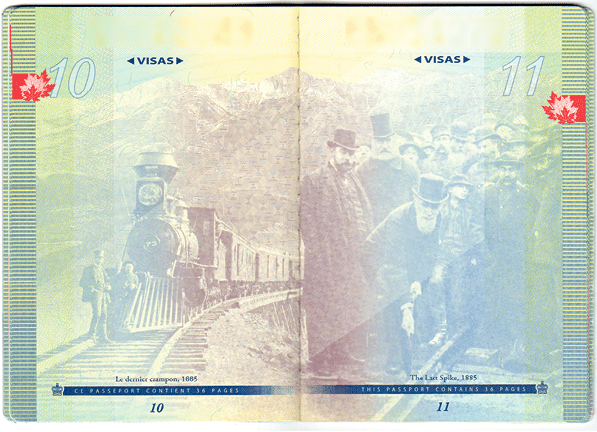Why so serious when it comes to passports
BY COLIN BREZICKI Special to the VOICE
Recently, I heard an American journalist remark that there’s nothing funny in Canadian literature. On the same day, as if to underscore his point, my new passport came in the mail.
Complete with mandatory unsmiling photo.
Why is smiling forbidden in a passport photo? When I smile I look like me; when I don’t, I look dangerous—even I wouldn’t let me through.
I suppose our intelligence service has its reasons for making us all look menacing, but it’s just so out of character for Canadians to look grim. We’re famous for being nice, and yes, dammit, for smiling. Despite our freeze-your-face-off winters, prairie floods and summer droughts, Biblical plagues of black flies and mosquitoes, and zero Stanley Cups this century, we smile through it all with gritted teeth.
Our national humour is all the more remarkable when you consider we’re a country built on a bedrock of God-fearing Presbyterians, Calvinists, Methodists, Catholics and United Empire Loyalists, further stratified by generations of immigrants from war-torn, invaded, pillaged, and economically challenged countries over the past hundred years.
Knee-slappers, all.
Still, being Canadians, we do as we’re told. So when the photographer says, Don’t smile, we don’t, and we’re happy with that.
Humorists by nature, we know the importance of a straight face; not cracking a smile when you tell a joke sharpens the punch line.
Anyway, along with the photo that made me look like a terrorist, something else in my new passport caught my eye.
Its 35 pages now feature the icons of our history and culture, as selected by committee.
I flipped through pictures of somber Aboriginals standing beside an inukshuk, Samuel de Champlain and the Fathers of Confederation (all repressing the urge to smile for their passport daguerreotypes), the Last Spike, Canada’s North, the Prairies, Halifax, the Parliament Buildings, Niagara Falls, the Vimy Memorial, Quebec City, the RCMP Musical Ride, the Grey Cup and Stanley Cup, Nellie McClung, Terry Fox, the National War Memorial, Cape Spear and the Bluenose.
Nothing funny here. Not a smile anywhere. No John Candy, Leslie Nielsen, Wayne and Shuster, Jim Carey, Eugene Levy or Mike Myers.
I’m not joking.
We have a waterfall, a cape, mountains, wheat-fields, a railroad to run through them all, and a man on one leg who tried valiantly to do just that.
Ice-fields that accommodate our national game, which by the way, along with American football, seems to be the sum total of our culture according to Passport Canada.
It’s just as well I didn’t see the new passport before I posed for my photo. Otherwise—right, I’d be struggling to keep a straight face.
Our selection committee deftly sidesteps the culturally highfalutin’ and keeps things simple. Canada with all the fixins. Maybe Don Cherry chaired the group.
There isn’t an artist, writer, actor, director or musician of any kind;. We’re a nation of rugged terrain, politicians, soldiers and hockey players.
That gives us not a lot to declare when we go abroad.
“Can I see your passport, please?”
“Sure. My name is Joe and I am Canadian.”
“Please, can you explain to me what are all these pages?”
“Well, they represent Canada. They’re our history and culture.”
“But I see only rocks and wheat and politicians. A sailboat, yes, and a very courageous man running on one leg, but people playing ice hockey and American football is your culture?”
“Well, yeah, but there’s way more than that. How about two world wars? On this page, see? Sorry, Gunther, but your team lost, two and out. And women got the vote on our little Nellie, not yours. And this here’s Niagara Falls, one of the seven natural wonders, pal, so you can put that in your Meerschaum and smoke it.”
“Yes, but of course we have many natural wonders in Germany also. The Alps. The Black Forest—famous for the cake and the ham. The Elbe Sandstone Mountains. The Danube. The Rhine. Just, we don’t regard these things as achievements. So tell me, why in your passport you have no pictures of your artists, your writers and musicians? Here we have Durer and Holbein, Beethoven and Mozart, Hegel and Schlegel and Goethe—statues of these people everywhere.”
“Not very funny though, were they?”
“Good point. We Germans wish we could laugh more, be like you Canadians. But please, my question. Are there no artists, musicians or writers in Canada? Noteworthy people?”
“Okay, Gunther, I’ll just give you the shortlist because we’re holding up the line here. Emily Carr, and the Group of Seven. Glenn Gould, Oscar Peterson and Ben Heppner. Leonard Cohen, Neil Young, Sarah McLachlan, Joni Mitchell. Christopher Plummer, William Hutt and Donald Sutherland. Alice Munroe, Mordecai Richler (even the Americans found him funny), Gabrielle Roy, Margaret Laurence, Margaret Atwood. Norman Jewison, Norman Bethune, Frederick Banting, Romeo Dallaire, Marshall McLuhan, Roberta Bondar and Chris Hadfield. That’s off the top of my head. Oh, and Tim Horton.”
“So tell me please why they are not mentioned in the culture pages of your passport?”
“Well, um, because we don’t want them to think they’re better than anyone else. It’s that whole tall poppy thing—lowers everyone else’s self-esteem.”
“Ha ha. You Canadians. Always joking. We like your sense of humour. You’re famous for it. Thank you and have a good day.”
“You too, Gunter, keep smiling.”
“And don’t forget your passport.”



